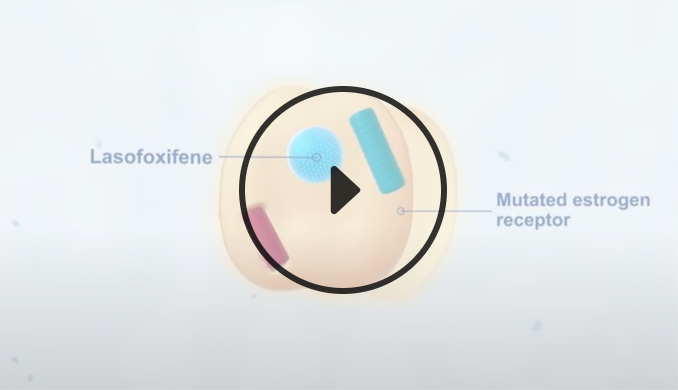Resources
Glossary
This glossary defines some of the most common terms associated with metastatic breast cancer.
ADVERSE REACTIONS
An undesirable outcome of medical care typically suspected to be associated with a drug. Adverse reactions are not caused by an underlying disease.
AROMATASE INHIBITORS
A class of drugs used in the treatment of breast cancer in postmenopausal women. These medications lower estrogen levels by stopping an enzyme in fat tissue (called aromatase) from changing other hormones into estrogen, which can fuel the growth of breast cancer cells.
CDK 4/6 INHIBITORS
Drugs that are designed to interrupt the growth of cancer cells by targeting enzymes (called CDK 4 and CDK 6) that are important in cell division.
ENDOCRINE THERAPY
Also called hormone-blocking therapy or hormone treatment, endocrine therapy is used to treat cancers that use hormones to grow, such as breast cancer. It is used to slow or stop the growth of hormone-sensitive tumors by blocking the body’s ability to produce hormones or by interfering with the effects of hormones on breast cancer cells.
ER+/HER2-
About 70% of all breast cancers are ER-positive (ER+), which means that the cancer cells grow in response to the hormone estrogen.1 HER2 is a protein that helps breast cancer cells grow quickly. Breast cancer cells with lower-than-normal levels of HER2 are called HER2-negative (HER2-). Individuals with ER+/HER2- breast cancer are likely to benefit from hormone therapy and may benefit from chemotherapy.
ESTROGEN RECEPTOR 1 (ESR1) MUTATIONS
The ESR1 mutation is an acquired mechanism of resistance to endocrine therapy. It is reported in approximately one-third of metastatic breast cancer patients and primarily among those treated with endocrine therapy.
ESTROGEN RECEPTOR POSITIVE (ER+)
Breast cancers that have estrogen receptors—cells that have a protein that binds to the hormone estrogen—are called ER-positive (ER+) cancers. These cells may need estrogen to grow. These cells may stop growing or die when treated with substances that block the binding and actions of estrogen.
ESTROGEN RECEPTOR-POSITIVE (ER+) METASTATIC BREAST CANCER
The cells of this type of breast cancer have receptors that allow them to use the hormone estrogen to grow. Estrogen receptors are proteins in or on the cells that can attach to estrogen in the blood. Treatment with anti-estrogen hormone (endocrine) therapy can block the growth of the cancer cells.
LASOFOXIFENE
Lasofoxifene is a novel targeted endocrine agent being studied in women and men with locally advanced or metastatic estrogen receptor-positive/human epidermal growth factor 2-negative (ER+/HER2-) breast cancer expressing an ESR1 mutation.
METASTATIC BREAST CANCER (mBC)
Cancer that begins in breast tissue, then moves to other areas of the body, is called metastatic breast cancer (mBC). You may also hear metastatic breast cancer referred to as “stage IV breast cancer.”
OVARIAN SUPPRESSION
A type of treatment that stops the ovaries from making estrogen, either temporarily or permanently.
OVERALL SURVIVAL (OS)
The length of time from diagnosis (or the start of treatment) to death. It is generally an indication of how well a treatment works.
PROGRESSION-FREE SURVIVAL (PFS)
The length of time from treatment initiation until disease progression or worsening. It conveys the chances of staying free from disease progression after a particular treatment. In a clinical trial, measuring the progression-free survival is one way to evaluate new drugs and treatments.
SELECTIVE ESTROGEN RECEPTOR DEGRADERS (SERDs)
A type of drug that binds to the estrogen receptor and destabilizes it by eradicating its signaling pathway.
Media
Discover the inspiration behind the ELAINE studies
Watch Dr. Miriam Portman – Co-Founder and Chief Operating officer – speak about the history of Sermonix Pharmaceuticals, how her sister inspired the ELAINE Studies.
Silke’s ELAINE study story
Silke sits down and shares her story about when she was diagnosed with breast cancer. She takes us through her treatment process and the challenges that came with it. Having failed treatments within 5 months, Silke shares how she became aware of genomic testing, and how it helped her find the treatment that was best for her.
How might lasofoxifene work?
Take a look at the theoretical mechanism of action (MOA) being tested in our ELAINE studies.

Lori’s story
Learn about the journey of a potential patient to the ELAINE-3 clinical trial in this fictional story.
Send me the latest news
By subscribing, you agree to receive the latest news and updates from us.
Reference: 1. Scheidemann ER, Shajahan-Haq AN. Int J Mol Sci. 2021;22(22):12292.


